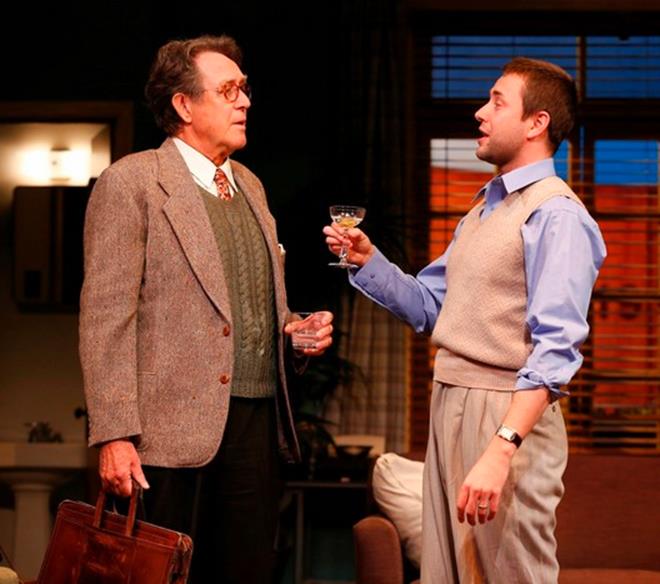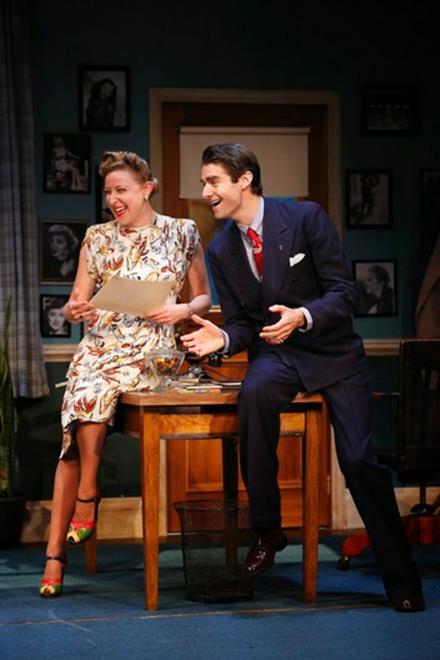Billy & Ray
Charmingly lighthearted comedy drama portraying the troubled collaboration of writer Raymond Chandler and director Billy Wilder over "Double Indemnity."

Larry Pine and Vincent Kartheiser in a scene from “Billy & Ray” (Photo credit: Carol Rosegg)
[avatar user=”Victor Gluck” size=”96″ align=”left” ] Victor Gluck, Editor-in-Chief[/avatar]In 1943, Viennese film director Billy Wilder, with two Hollywood writing-directing credits on his résumé, had a falling out with his regular writing partner Charles Brackett. Wilder wanted to make a movie of that unfilmable novel, James M. Cain’s Double Indemnity, but Brackett felt the novel was based too much on sex and violence. Paramount Producer Joe Sistrom had already paid $15,000 for the film rights, a large sum in those days. So the problem became finding Wilder a new writing partner. He didn’t want to use any of the studio screenwriters as he wanted to do something new, fresh and original and shake up the system in the process. He wanted to work with hard-boiled detective novelist Raymond Chandler, author of the Philip Marlowe stories, who it turned out did not know the movie business.
Mike Bencivenga’s Billy & Ray is the story of Wilder and Chandler’s famously contentious collaboration. The lighthearted comedy drama includes an insider’s view of Hollywood and a good many famous anecdotes about their fighting over the Double Indemnity screenplay. While it will probably be enjoyed most by those who know the movie and/or the original novel, the play does clue the audience in to what they need to know about the original material as well as its eventual screen treatment. While the play is not a film noir itself nor do sparks really fly, Billy & Ray is an entertaining historical recreation of a true Hollywood story. Previously produced at the Falcon Theater of Burbank, California, Billy & Ray was originally directed by film and television legend Garry Marshall who repeats his proficient duties for the New York production.
Set in the writers’ building at Paramount Pictures, the play begins in the dark as we hear Wilder and Brackett’s volatile break-up. When the lights come up, Sistrom and Wilder debate where to find a new collaborator. Wilder says he doesn’t want another screenwriter but a book writer, “Somebody good at this kinda crime stuff.” As Cain turns out to be working on another picture and unavailable, Wilder suggests Chandler who he has been reading in Black Mask magazine. When Chandler arrives he is a disappointment to Wilder: instead of a tough private eye, he looks like a bespectacled, tweed-jacketed academic which he turns out to have been. Chandler is refused permission to work at home (due to William Faulkner’s ploy), so he instead offers to write the entire screenplay for a flat fee in ten days.
The result is too literary as Chandler has little experience with writing for the screen, and he reluctantly agrees to come to Wilder’s office from 9 – 4 daily. However, Chandler and Wilder are very different types and they rub each other the wrong way from the beginning. Chandler likes to smoke a pipe; Wilder likes to smoke a cigar. Wilder wants the windows open; Chandler doesn’t trust the air of Los Angeles. Man-of-the-world Wilder laces his conversation with profane language to which Chandler is offended. Chandler can’t take loud noises while Wilder likes to pace and yell when he is pleased by a new idea. Wilder wants to use Cain’s dialogue from the novel, while Chandler is certain that he can do better. And worst of all, Wilder likes to have alcoholic drinks all day long while Chandler, a recovering alcoholic, claims to be a teetotaler.

Sophie von Haselberg and Drew Gehling in a scene from “Billy & Ray” (Photo credit: Carol Rosegg)
However, as they go through the story point by point, the eventual screenplay is built up and original and ground-breaking new ideas never yet seen in an American film are introduced, like letting the audience in on the ending in the very first scene through the protagonist’s narration. We watch as Wilder and Chandler bargain their way through their differences and the amusing way that the casting was assembled for this seemingly tawdry property that had turned many people off. The play also shows how these clever men were able to get around the motion picture code and make this a movie first in many ways, often called the first example of film noir. Occasionally, designer Russell H. Champa has the lights dim as the men imagine a moment in the film and we are in the realm of the dark shadows and tense plotting which has come to define the genre.
Veteran actor Larry Pine inhabits the role of the sickly, methodical Chandler who had been a school teacher earlier in his career, though the script does not allow him much in the way of sparks other than intelligent and creative solutions to their film problems. Mad Men‘s Pete Campbell, Vincent Kartheiser has a strong hold on his German accent though it may not be convincingly Viennese but he successfully makes the womanizing and high-living Wilder a difficult personality. Drew Gehling renders producer Joe Sistrom a credibly conflicted man being given ulcers by the studio’s censorship of anything that smacks of adult behavior. As Wilder’s attractive young secretary, Sophie von Haselberg (a dead ringer for her mother Bette Midler), making her New York stage debut, is amusing as a woman who has already seen and heard it all and puts up with her boss’ outrageous demands in order to stay in the movies.
Marshall’s direction is quite leisurely for what is essentially a comedy drama, but the humor and jokes fall well and the play’s farcical moments have the ring of truth. Charlie Corcoran’s office settings are both suitable and serviceable for the play’s several studio locations. The period-perfect costumes particularly for von Haselberg’s secretary and Gehling’s producer are by Michael Krass. The elegant original music and sound design is the work of David van Tieghem. Billy & Ray will be of most interest to film buffs, devotees of film noir, and the fans of Chandler, Wilder and Barbara Stanwyck who ultimately walked away with the movie (but does not put in an appearance in the play).
Billy & Ray (extended through November 23, 2014)
Vineyard Theatre, 108 E. 15th Street, east of Union Square, in Manhattan
For tickets, call 212-353-0303 or visit http://www.vineyardtheatre.org
Running time: two hours including one intermission






Leave a comment